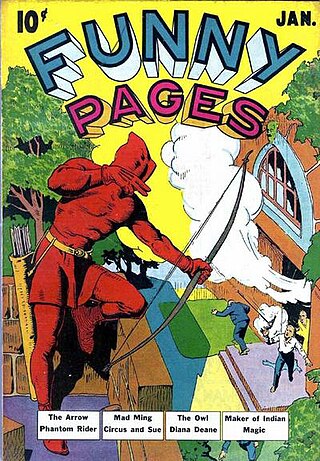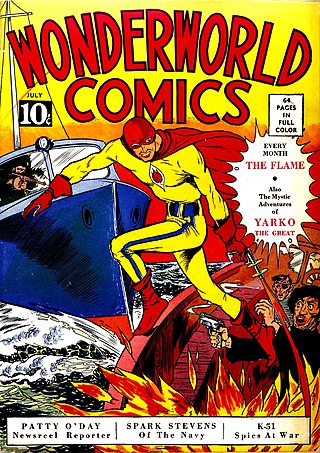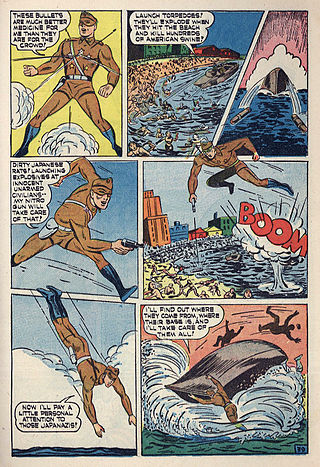
Daredevil is a fictional superhero created by Jack Binder, who starred in comics from Lev Gleason Publications during the 1930s–1940s period historians and fans call the Golden Age of comic books before being retroactively established into the Image Universe by Image Comics in the 1990s as its first character. The character is unrelated to Marvel Comics' Daredevil, and recent renditions of the character have often renamed him Doubledare or The Death-Defying Devil to avoid confusion and potential lawsuits.

The Fighting Yank is the name of several superheroes, first appearing in Startling Comics #10.

Crestwood Publications, also known as Feature Publications, was a magazine publisher that also published comic books from the 1940s through the 1960s. Its title Prize Comics contained what is considered the first ongoing horror comic-book feature, Dick Briefer's "Frankenstein". Crestwood is best known for its Prize Group imprint, published in the late 1940s to mid-1950s through packagers Joe Simon and Jack Kirby, who created such historically prominent titles as the horror comic Black Magic, the creator-owned superhero satire Fighting American, and the first romance comic title, Young Romance.

The Arrow is a fictional superhero created during the Golden Age of Comic Books. He was the first superhero published by Centaur Publications.
Hydroman is a fictional superhero character who first appeared in comic books from Eastern Color Printing in 1940.

The Skyman is a fictional comic book superhero that appeared stories during the Golden Age of Comic Books. Created by writer Gardner Fox and artist Ogden Whitney, the character first appeared in the Columbia Comics omnibus title Big Shot Comics #1. He is unrelated to the DC Comics character.
The Green Mask is the name of two comic book superheroes, both published by Fox Feature Syndicate. Both are in the public domain with some of the original stories having been reprinted by AC Comics.

The Flame is a superhero that appeared in American comic books published by Fox Feature Syndicate. The Flame first appeared in Wonderworld Comics #3 and was created by writer Will Eisner and artist Lou Fine. The Flame became Wonderworld's primary character.

Miss Masque is a fictional masked crime-fighter. She originally appeared in comic books published by Nedor Comics, and was later revived by AC Comics, America's Best Comics, and Dynamite Entertainment.

Pyroman is a fictional superhero that appeared in comic books published by Nedor Comics. His first appearance was in Startling Comics #18, with art by Jack Binder. This character was later revived by both AC Comics and America's Best Comics.

The Woman in Red is a fictional character that first appeared in the period known to comic book historians as the Golden Age of Comic Books. Created by writer Richard E. Hughes and artist George Mandel, she first appeared in Thrilling Comics #2, published by Nedor Comics. The character was later revived by writer Alan Moore for America's Best Comics. She would also be used by Dynamite Entertainment in Project Superpowers Chapter Two.

The Face is a fictional character, a comic book superhero that appeared in 1940s comics during what historians and fans call the Golden Age of Comic Books. He was created by artist Mart Bailey and an unknown writer.

Firefly is a superhero created by Harry Shorten and Bob Wood for MLJ Comics in 1940. He first appeared in Top-Notch Comics #8. Artist Warren King and writer Joe Blair loaned their talents to many of the Firefly's installments.

The Target and the Targeteers are fictional characters, a trio of superheroes who first appeared in 1940, in Target Comics from Novelty Press.
The Owl is a fictional superhero that first appeared in Dell Comics' Crackajack Funnies #25, continuing until #43.
Yank & Doodle is a pair of superheroes who first appeared in the Prize Publications title Prize Comics in August 1941. They were revived by Dynamite Entertainment in the 2000s.

Silver Streak is a fictional superhero character created by Joe Simon that first appeared in Silver Streak Comics #3, from Lev Gleason Publications. He is believed to be the second-ever comic book superhero whose primary power is speed; All-American Publications' The Flash preceded him by two months. However, Silver Streak beat out National Allied Publications' Johnny Quick as the first superhero whose two powers were speed and flight. Silver Streak has a kid sidekick called "Mercury" ; he is also assisted by a falcon named "Whiz".
Captain Courageous is a fictional superhero character who first appeared in Banner Comics #3 from Ace Comics.

Captain Future is a fictional superhero character who first appeared in Startling Comics #1 from Nedor Comics.

The Unknown Soldier is a fictional superhero character who first appeared in Our Flag Comics #1 from Ace Comics. The comic was devoted to patriotic superheroes, and also included Captain Victory and the Three Cheers.















